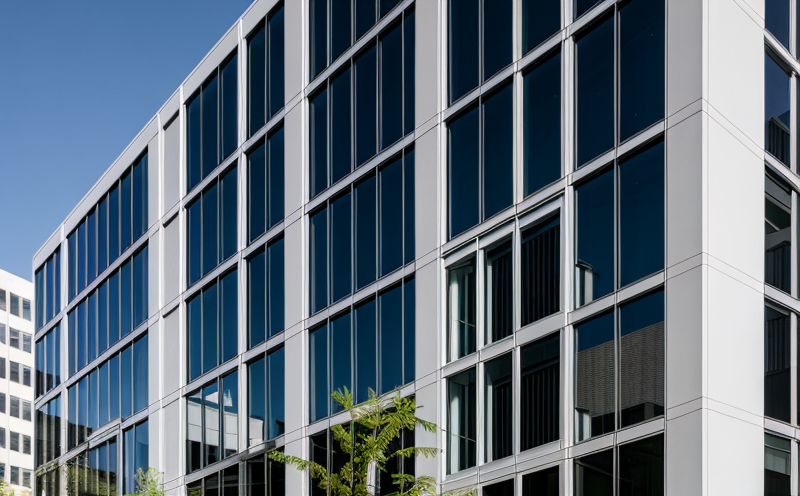ISO 12543 Laminated Glass Fragmentation Testing
The ISO 12543 standard is a critical benchmark for assessing the performance of laminated glass in terms of its ability to resist fragmentation during impact events. This service ensures compliance with international standards, providing peace of mind that the glass used in construction and infrastructure projects will perform as expected under various stress scenarios.
Laminated glass consists of two or more layers of glass with a plastic interlayer between them, typically made from polyvinyl butyral (PVB). The purpose of this testing is to evaluate how effectively the PVB layer holds the glass together when subjected to impact. Proper fragmentation performance ensures that shards remain bonded and do not scatter widely, which can be crucial for safety in buildings and infrastructure.
The test involves subjecting a sample of laminated glass to an impact from a specified weight dropped from a defined height. The primary objective is to observe the behavior of the glass under such conditions, particularly focusing on whether it remains intact or breaks into controlled pieces. This testing is essential for ensuring that safety standards are met and that the glass meets the required performance criteria.
The methodology outlined in ISO 12543 specifies a standardized approach to conducting these tests, which includes precise details about specimen preparation, environmental conditions, test equipment, and evaluation criteria. Compliance with this standard guarantees reliability and consistency across different manufacturing processes and locations.
Understanding the significance of laminated glass fragmentation testing is vital for architects, engineers, and construction professionals who rely on such materials to enhance safety standards in various applications. By adhering to these stringent tests, they ensure that their projects meet both regulatory requirements and industry best practices.
In addition to ensuring compliance with international standards like ISO 12543, this testing also supports broader goals related to product quality assurance and risk management within the building & infrastructure sector. It helps identify potential weaknesses in design or manufacturing processes early on, allowing for necessary adjustments before widespread deployment of materials into projects.
Through rigorous adherence to these tests, stakeholders can confidently select high-quality laminated glass solutions that contribute significantly towards creating safer environments both indoors and outdoors.
Why It Matters
The importance of ISO 12543 Laminated Glass Fragmentation Testing cannot be overstated in the context of building & infrastructure testing. This standard plays a pivotal role in safeguarding public safety by ensuring that critical components like windows and doors can withstand potential impacts without posing hazards.
During construction, it's essential to verify that materials used meet not only basic structural integrity standards but also those related specifically to safety performance during emergencies or accidental occurrences. For instance, laminated glass is often specified in high-risk areas such as atriums, stairwells, and entranceways where large numbers of people gather frequently.
Compliance with ISO 12543 helps reassure clients that the products they are investing in comply with relevant regulations and best practices. This not only protects against liability risks but also enhances overall confidence in the project's quality assurance process.
Incorporating this testing into procurement strategies ensures that suppliers deliver consistent, reliable materials across multiple projects, reducing variability and enhancing uniformity of performance outcomes. Consequently, this contributes positively towards achieving long-term goals associated with sustainable development practices within the construction industry.
Why Choose This Test
- Possesses high reliability in assessing the integrity of laminated glass under impact conditions.
- Provides a standardized approach for consistent evaluation across different manufacturers and locations.
- Safeguards public safety by ensuring that critical components perform as expected during emergencies or accidental occurrences.
- Supports broader goals related to product quality assurance and risk management within the building & infrastructure sector.
This testing is particularly beneficial for architects, engineers, and construction professionals who rely on such materials to enhance safety standards in various applications. By adhering to these stringent tests, they ensure that their projects meet both regulatory requirements and industry best practices.
The inclusion of ISO 12543 Laminated Glass Fragmentation Testing in procurement strategies ensures consistent delivery of high-quality laminated glass solutions across multiple projects, thereby reducing variability and enhancing uniformity of performance outcomes. This contributes positively towards achieving long-term goals associated with sustainable development practices within the construction industry.
Environmental and Sustainability Contributions
The ISO 12543 Laminated Glass Fragmentation Testing plays a significant role in promoting environmental sustainability by contributing to safer, more resilient buildings. By ensuring that laminated glass meets stringent performance criteria during impact events, this testing helps prevent the release of harmful debris into the environment.
When properly tested and installed, laminated glass can significantly reduce the risk of injury caused by flying shards during accidents or natural disasters. This not only protects occupants but also minimizes cleanup efforts following incidents, thereby reducing waste generation and associated environmental impacts.
Incorporating sustainable practices into construction projects requires careful consideration of material selection and usage throughout the lifecycle of a building. Laminated glass testing supports these initiatives by providing assurance that selected products will perform reliably over time without compromising safety standards.
Furthermore, compliance with international standards like ISO 12543 promotes transparency and accountability among stakeholders involved in designing and constructing sustainable structures. It fosters collaboration between architects, engineers, manufacturers, and end-users to develop solutions that balance aesthetic appeal with practical functionality while adhering to rigorous environmental benchmarks.





